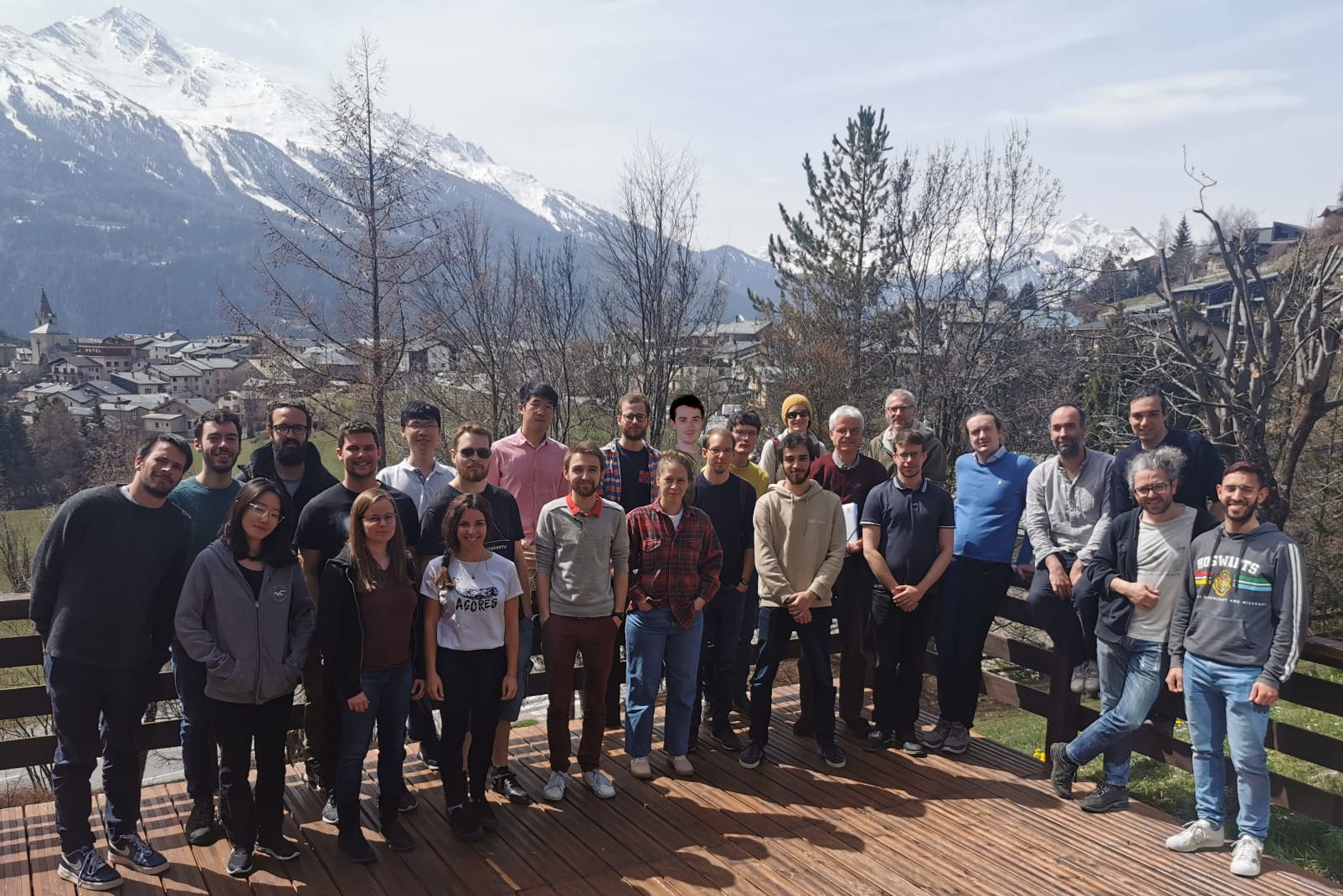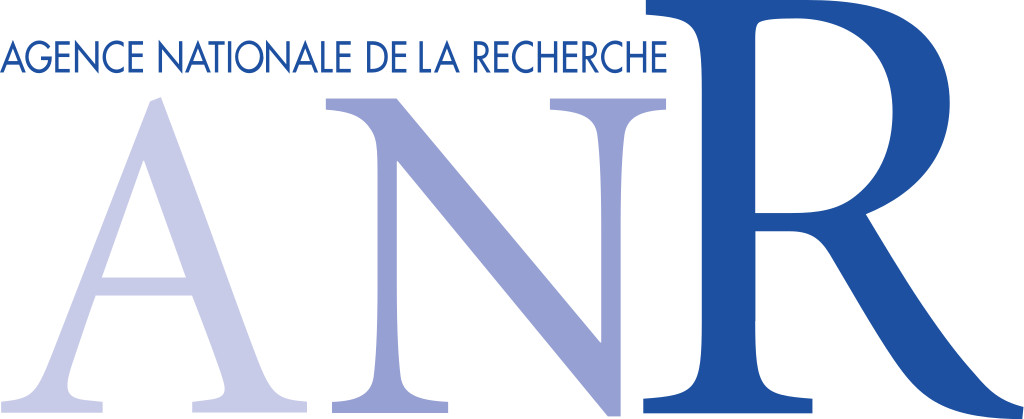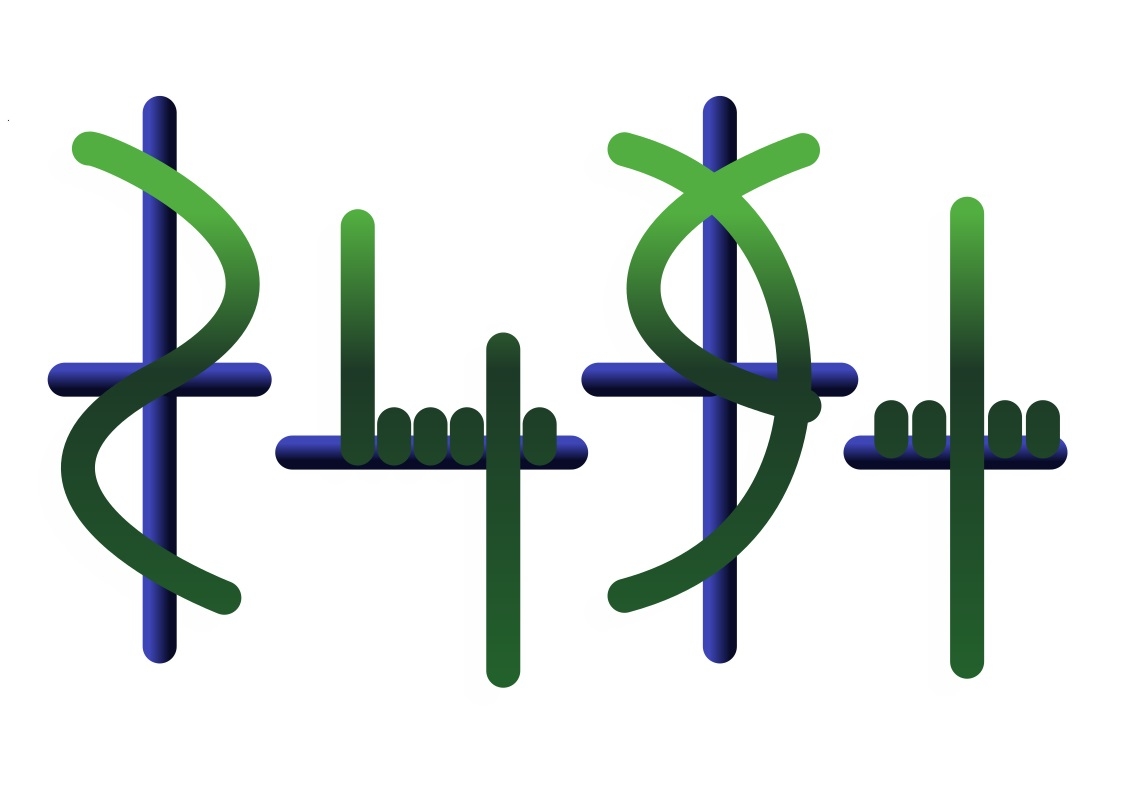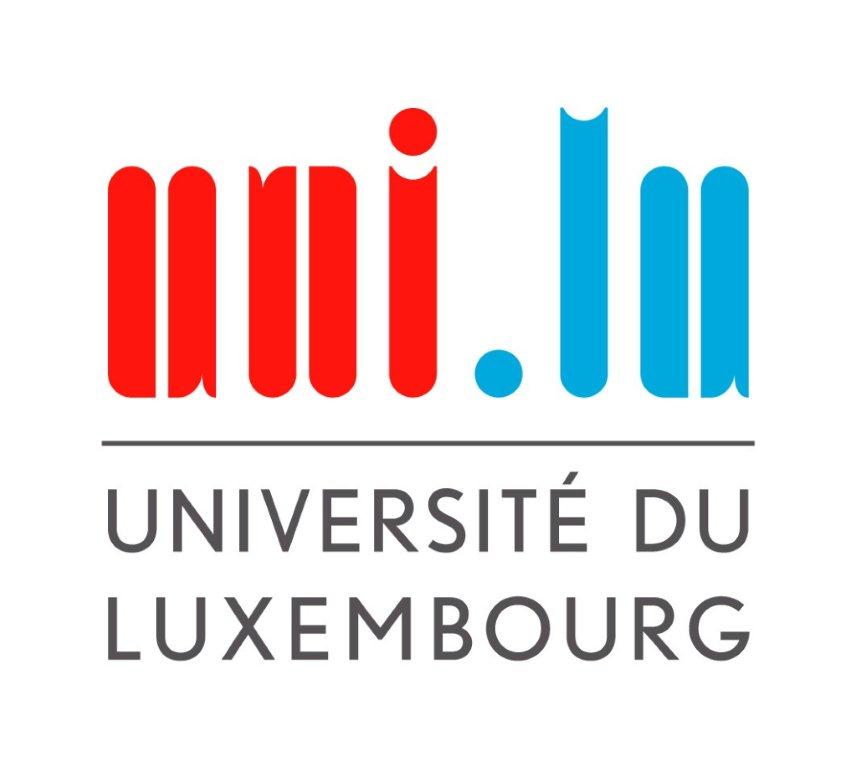Practical information
This workhsop will take place in Aussois from the 10th to the 15th of April 2022. More informations soon!Presentation of the workshop
This workshop aims at bringing together mostly young researchers to spend one week studying a topic in low dimensional topology. Part of the week is dedicated to detailed talks taking time to introduce the background of the theory necessary to tackle more recent questions. Time is voluntarily made available to encourage discussion that the presentations will generate.
For this second edition, the object of study is the relation between knot theory and four dimensional topology. After series of talks presenting relations between handle decomposition of four manifolds and knot theory, we will see how the notion of sliceness for links is related to construction of exotic pairs of manifolds. Then we will have discussions on invariants of knots that could measure such properties. We will focus mostly on invariants coming from quantum topology such as the Jones polynomial and its derivatives. It will be the good occasion to study topological notions in dimension 4 surrounding this framework.

Chalk drawings by Jacques Darné
Program
The full program can be downloaded here.A starting reference for this talk might be the first chapter of Arunima Ray’s lecture notes at Winter Braid [Ray]. In particular the speaker should take some time to explain the ”movie” picture, and to prove Proposition 1.3 therein. There exist many other references, including [Owen, Tei] For knot concordance, a good starting point is the second section of Teichner’s lectures notes [Tei]. In particular, Theorem 2.4, Proposition 2.6 and Corollary 2.11 therein should be presented. Note that a proof of Theorem 2.11, will be a central ingredient of the talk of Fox–Milnor’s theorem. Other possible sources are [Owen, Ray, Liv].
This talk could explain what are handles and handle decompositions (see [GS, Section 4.1]), why every smooth manifold admits handle decompositions (see [GS, Section 4.2]), how to relate different handle decompositions of the same manifold by handle moves (see [GS, Proposition 4.2.9] for creation/removal of canceling pairs, [GS, Definition 4.2.10] for handle slides, and [GS, Theorem 4.2.12] for the completeness of this set of moves), how to visualize and represent diagrammatically handles and handle decompositions (see [GS, Section 4.4] for a brief discussion of 1∕2-handles and an explanation of why we don’t need to represent 3∕4-handles in the closed case, see [GS, Section 5.4] for the dotted circle notation for 1-handles), and how to visualize and represent diagrammatically handle moves (see [GS, Section 5.1] for creation/removal of canceling pairs, handle addition/subtraction, blow-ups/blow-downs). Other possible references: [FM, Sections 9.2 & 9.3], [Sc, Sections 1.2, 1.3, & 2.5], [Ak, Sections 1.1–1.4].
Notes.
This talk could explain how to represent diagrammatically handle decompositions of disc bundles (see [GS, Example 4.1.4, Exercise 4.1.6]), projective spaces (see [GS, Examples 4.2.4 & 4.4.2, Exercise 4.2.5]), sphere bundles (see [GS, Section 4.6 up to Exercise 4.6.1]), plumbings (see [GS, Example 4.6.2]), doubles (see [GS, Example 4.6.3]), bundles over surfaces (see [GS, Example 4.6.5]), products with 3-manifolds (see [GS, Example 4.6.8]).
The aim of this talk is to give details of the construction sketched in Arumina Ray’s lecture notes [Ray]. In particular, one would need to give details about Quinn’s theorem and to explain what an exotic ℝ4 would look like. References: [BKKPR, GS, FQ].
The Fox–Milnor theorem asserts that the Alexander polynomial of a slice knot factorizes as f(t)f(t-1). Elementary proof for ribbon knots. Proof for general slice knots [Lic, Proposition 8.17].
The idea is to study the behaviour of (this time) the Jones polynomial for ribbon knots following [Eis]. The first property (Theorem 1) says that for an n-component ribbon link, the nullity (multiplicity of the zero at q = i) of the Jones polynomial is exactly n - 1. The definition of the Jones polynomials in terms of skein relations is expected (Theorem 2.2), without any proof. A basic algebraic study (Sec. 2, involving usual notions of Seifert surfaces/matrix, signature...) should be conducted leading to the upper bound (Lemma 1) of the Theorem 1 (for any link). For the lower bound part, the notion of band diagram and ribbon link could be recalled from the Talk 1 of the workshop. The strategy of proof for Prop. 4.1 (lower bound for ribbon links) has to be presented: applying Kauffman skein relations to ribbon band moves. The consequence of Theorem 1 could be outlined: first the notion of surface invariants of finite type w.r.t. band crossing changes (Sec. 5), second the statement of Theorem 2.
Definition (unbalanced), stabilization moves, proof of existence via Morse functions [LCM, Section 2.1], diagrams, relation between trisection diagrams and Kirby diagrams (both directions). [GK, Gay]
Notes.
”Two trisections of a given smooth 4–manifold can be made isotopic by some number of stabilizations” [GK]. Proof via Morse functions and homotopy between Morse functions.
The aim of this talk is to introduce the audience to the intersection form on 4 manifolds. A good occasion for that is to give a proof of Rohlin theorem. Reference: Saveliev, ”Lecture on the topology of 3-manifolds”,[Sav]. Then saying a word on the Rohlin invariant might make no harm. If time permits, say a word on the surgery formula for Rohlin invariant.
The aim of this talk is to give some insight on the proof of the theorem ΔK = 1 implies K is topologically slice. The main reference might be [BKKPR, Section 21.6.3], see also [FQ] and [GT, Appendix]. It seems that part of the argument relies on a delicate Theorem (Disc embedding theorem), and we clearly do not have time to provide a proof of this technical important point. The speaker should rather explain how the theorem of Freedman is related to this point, and say what is possible to say in the given time.
We will outline a construction of Piccirillo and Manolescu that produces many candidates for exotic smooth structures on S4. We will explain how pairs of knots K,K′ with homeomorphic 0-surgeries but with K slice, K′ non slice may be used to produce an exotic sphere.
Then we will discuss the RGB link construction that produces many pairs of knots (K,K′) with diffeomorphic traces, and how to extract good candidates from this construction.
References: [MP21]
We will sketch the construction of Khovanov’s link homology Kh(L) that categorifies the Jones polynomial. We will also present a variation of Khovanov’s homology Kh′(L), introduced by Lee, which is related to Khovanov’s by a spectral sequence and we will show that for a knot K, one has simply has Kh′(K) = ℚ ⊗ ℚ as vector space. The information in Lee’s homology is purely contained in the gradings; we will discuss how to compute gradings and bases for Lee’s homology, and how to sometimes compute Lee’s homology from Khovanov homology using the spectral sequence.
References: [Ras10] [Lee02]
We will explain how the grading information contained in Lee’s homology gives rise to a concordance invariant (now known as Rasmussen’ s invariant). We will explain how this invariant can be compared to other classical concordance invariants such as knot signatures.
As a second part of the talk, we will review some new techniques of Piccirillo. We will review how knots with diffeomorphic knot traces can be used to obstruct sliceness, and will sketch the RGB link construction that produces examples of pairs of such knots. Finally, we will apply this technique to the case of the Conway knot, and deduce the non sliceness of the Conway from the non sliceness of another knot with the same trace, for which the s invariant can obstruct sliceness.
References: [Ras10][Pic18]
In this talk the speaker should define what a knotted surface in dim. 4 means. Then the language of broken surface diagrams must be presented: namely how to represent an embedding of a surface in a 4-manifold using these objects [CS, CKS]. The theorem of Roseman [R] will be presented, at least displaying the moves on broken surfaces diagrams under which the knotted surface is unchanged. They are an analogue of Reidemeister moves for knot diagrams. We expect the speaker to explain this invariance for some moves, at least giving a flavour [R, CS]. Why Roseman set of moves is sufficient should be mentioned and maybe outlined [R], as well as the redundancy in the moves [Y, K]. As an illustration, the speaker will sketch the proof (only a few cases) that tricolorability is an invariant of knotted surfaces, by showing that it remains unchanged under Roseman moves [D]. The construction of this talk could be helped by [AM].
In this talk, we study another category of diagrams associated with knotted surfaces, called cut-diagrams [AMY]. They can be seen as a generalization of Gauss diagrams for knots. The speaker will explain the construction of cut diagram from a broken surface diagram, then the general definition of cut diagrams of [AMY]. A translation of Roseman moves in terms of cut-diagrams moves will also be presented. The question of the injectivity of the map from knotted surfaces to cut diagrams will be discussed (Tanaka’s result that the peripheral system is not a complete invariant [T], unlike in the knot case [W], should be mentioned). If time allows, the speaker will define Milnor-like invariants [Mi] associated with cut diagrams, and explain why it is a concordance invariant and/or why it vanishes on knotted spheres [AMY]. The speaker could also show how tricolorability of knotted surfaces extends to cut-diagrams. The construction of this talk could be helped by [AM].
The aim of this talk is to explain the strategy of Hayden and Sundberg [HS] to construct exotic pairs of surfaces in B4, these surfaces are isotopic through ambient homeomorphisms but not through ambient diffeomorphism. The main tool is to evaluate their corresponding classes in Khovanov homology against a well-chosen element.
Participants

- Giulio Belleti
- Léo Bénard
- Boris Colombari
- Marco De Renzi
- Renaud Detecherry
- Jacques Darné
- Quentin Faes
- Daniel Galvin
- Emmanuel Graff
- Hyenhee Jin
- Corentin Lunel
- Stavroula Makri
- Yohann Mandin
- Manos Manouras
- Laura Marino
- Jules Martel
- Gregor Masbaum
- Jean-Baptiste Meilhan
- Delphine Moussard
- Louis-Hadrien Robert
- Anthony Saint-Criq
- Leo Schelstraete
- Pablo Toro-Sanchez
- Paula Truöl
- Arno Wildi
- Bangwin Wang
- Hao Xu
Schedule
The full program can be downloaded here.
Monday, April 11th
- 09:30-10:30: Makri
- 11:00-12:00: Sánchez
- 14:30-15:30: Faes
- 16:00-17:00: Wildi
Tuesday, April 12th
- 09:30-10:30: Manouras
- 11:00-12:00: Graff
- 14:30-15:30: Saint-Cricq
- 16:00-17:00: Moussard
Wednesday, April 13th
- 09:30-10:30: Galvin
- 11:00-12:00: Mandin
Thursday, April 14th
- 09:30-10:30: Truöl
- 11:00-12:00: Schelstraete
- 14:30-15:30: Jin
- 16:00-17:00: Marino
Friday, April 15th
- 09:30-10:30: Darné
- 11:00-12:00: Colombari
Organizers
- Léo Bénard (Universität Göttingen)
- Marco De Renzi (Universität Zürich)
- Jules Martel (Université de Bourgogne, Dijon)
- Delphine Moussard (Aix-Marseille Université)
- Louis-Hadrien Robert (Université du Luxembourg)





